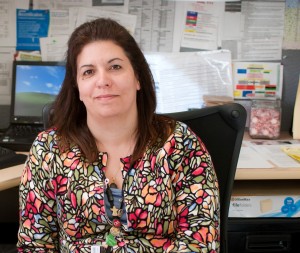By Marcy Rushford
The planned move of our Magnetic Resonance Imaging (MRI) equipment into its new home on the ground floor of the Richards Building presented the hospital with an opportunity to update to the latest available technology. It also enabled us to take advantage of what we, as well as the whole imaging industry, have learned about how we can make patients more comfortable with Magnetic Resonance Imaging.

There’s a level of stress for any patient whenever he or she needs to have a diagnostic imaging test. While MRI isn’t frequently used in the immediate aftermath of a vehicle accident, but rather for evaluation of conditions that are more long standing, it still creates a feeling of anxiety for those undergoing this type of imaging.
As MRI suites have evolved, greater attention has been paid to the environment of care along with adjustments to the technology. The goal is to have a calming, even soothing, space that helps a patient stay relaxed. Here at BMH, we spoke with some of our patients about what triggered their nervousness. Their feedback contributed to our choice of light colors for the wooden floors and walls to create an open and airy feeling, almost like being outdoors. Lights can be brightened or dimmed as needed. We’ve even incorporated clouds on the ceiling and ocean scenes on the walls to foster a sense of depth and tranquility.
Improvements to the actual MRI equipment also contribute to the more relaxing environment. The model we purchased is one of the widest available, has a shorter table and is open on both ends to reduce a patient’s sensation of being enclosed. People who might have had an MRI here or somewhere else know a loud banging sound occurs during the test. This noise is caused by the gradients, which are used to improve image quality, during the imaging process. But new gradients available with the updated MRI technology minimize the noise significantly for patients who now have MRIs at Brattleboro. This reduction in noise was another consideration for improving the environment of care patients experience here.
Patient consideration is a component of the training our staff receives from the equipment manufacturer. Depending on the number of sequences ordered by the radiologist or health provider, an MRI test might last anywhere from 20 minutes to an hour. A tech will be very attentive to how a patient’s body is positioned, providing additional cushioning when possible. We have a supply of eye masks for people who want to rest, as well as earphones if patients want to listen to music, which they can select from our sound system or bring in a CD with their own music.
When a patient is more relaxed it can actually improve the outcome of the test. A nervous person might fidget around and create imperfections in the image. So far, the calmer patients combined with the increased resolution produced by the upgraded technology have produced some stellar images for the radiologists and doctors, with faster reconstruction of images. For patients, this means faster interpretation and diagnosis.
We began providing MRI services to breast cancer patients shortly before the new equipment was put into operation. This technology is being increasingly used for high risk patients. So it’s incredibly convenient to now have the new MRI suite just downstairs from oncology services and the Comprehensive Breast Care center. Having everything so well aligned just adds to the speed and efficiency with which we can provide care to all patients. Southern Vermont Orthopaedics is also in the Richards Building, and their joint replacement patients frequently get MRIs as part of the injury assessment process. New applications of the technology include advanced abdominal scans to detect Crohn’s disease, which will help minimize the potential radiation dosage to which these patients might be subjected.
The new MRI suite opened November 17. To date, we’re very happy with the feedback we’ve heard from both patients and technologists about the improved environment of care the new space provides and pleased with the additional diagnostic benefits it brings to the community.
Marcy Rushford, CRA, MBA, RDMS, RT(R,M) is the Director of the Radiology and Cardiology Unit at Brattleboro Memorial Hospital.
